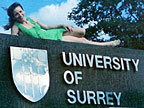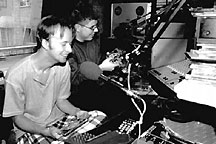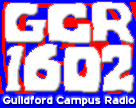




The induction loop system used by URS comprised a central transmitter in Studio 2, the output of which was then distributed through a series of coax cables and splitters, across the university campus to amplifiers under most of the halls of residence which amplified the signal and fed it into loops of wire under the buildings. The theory is that the field produced by these loops (which, for the technies, is mostly magnetic near field rather than electric far field radiation) remains very local giving a good signal in and around the buildings but reducing radiation off the campus to very low levels. Unfortunately the practicality is somewhat different: the signal is attenuated so quickly as it leaves the loops (it's a forth-power law, i.e. for every doubling of distance, the signal reduces by a factor of 16!) that even a few metres away it can be difficult to receive.
But that was only the start of the problems with the system. The feeder cables running underneath the university were forever being dug up by the university's ham-fisted works department. Many a temporary repair had been put into place but each dodgy fix reduced the signal feeding the amplifiers and hence the radiation from the loops. Even by 1987, the situation had gotten so bad that in many parts of the campus the signal had become unlistenable (especially at night when interference from Spanish station SER, illegally using excessive power of 10kW on 1602 kHz, increased the level of background fug).
Worse still, the transmitter generating the 1602 kHz signal was the original one built in 1978 when the frequency changed and as well as having a lower audio bandwidth than the new licence allowed (it had a filter limiting the frequency range to 4.5 kHz instead of the allowed 6.5 kHz), it had no audio processing, just a limiter to prevent over-modulation. So the whole thing sounded crap, was weak and was unreliable!
Having played about with audio processing for ZFM, I decided to play around with the transmitter to try and beef up the sound whilst the station was off-air over the summer break in 1988 (by now I had been elected Programme Controller for the station for the following academic year so I was allowed to do these things!) With the help of a Plessey SL-6270 'VOGAD' chip, and some other bits and bobs, the sound and bandwidth of the station were massively improved ready for the new term the following autumn.
During the year, due to another of the works department's 'accidents', the feeder to one of the halls of residence (Stag Hill) was once again cut and though another fix had been put in place as the signal to the amplifier at the end of the coax was so badly reduced that it was just about inaudible. At which point genius struck (it doesn't happen that often). I took the amplifier and put it at the point where the coax began instead of at the end, and instead of feeding the signal along the coax, I connected the outer of the coax to the output of the amplifier and used the coax as a (free radiating) antenna instead. The signal across the affected area (and in other parts of the campus) rocketed and what with the new beefy audio, for once URS could actually be heard. For the first time in a long while actually attracted an audience across the campus, albeit a rather small one. Being on AM when all the popular stations were on FM wasn't much fun.
Flushed with the success of my Stag Hill fix, over the following year or so, I disconnected the earth from most of the induction loops so that each acted as a free radiating antenna instead of a loop. Now the signal across the majority of the campus was solid, though the amount of leakage off the campus did give cause for concern to one or two of the old-guard, who believed we would have our collar felt at any moment for breach of licence terms (it never happened!) By the time I left the university, the transmission system just used the wires which were flown between the roofs of some of the accommodation blocks (in Surrey Court) which were fed as a crude dipole with a simple matching unit - truly 'free radiating'!
Over the summer holidays of 1989 we decided that the station needed a face-lift. It had been believed for a long time that the station must identify itself as University Radio Surrey as that was what was written in the licence but we wanted to give it a new name. Over a few pints in the union the name Guildford Campus Radio, oft shortened to GCR was born and we decided that if the authorities wanted to get snotty about the re-branding we would, on the hour, use the phrase 'This is Guildford Campus Radio the University radio station for Surrey', thereby maintaining the original name, albeit with a couple of extra words chucked in there for good measure. By the end of the first week of broadcasting, we'd gotten bored with that so we just got on with calling the station by its new name. New jingles were procured (the old Signal Radio 'setting the pace at the weekend' package re-sung as 'setting the pace on the campus') and a new logo designed and GCR was launched onto the campus with a flourish of excitement (well those involved in the station were excited anyhow).
As an aside, there were other names considered for the station including Surrey Campus Radio and Surrey Student Radio (it was felt that all the 's's made them too sibilant), Stag Hill Independent Transmissions (I'll let you figure out the acronym) and Campus & U (the campus ampers-and you!)
As time progressed, our frustration at not being on FM increased and so we thought up increasingly devious schemes that would allow us to legally broadcast to the campus on FM. None of them came to anything, however, but as most ot the station staff lived within a few hundred metres of the studio, a low-power FM transmitter was installed in the studio to provide a stereo feed to these station members (for monitoring purposes you understand). We never advertised the service and as the power was probably no more than 5 milliWatts I doubt anyone in officialdom ever noticed. But it made us realise how much better GCR 98.7 FM was than GCR 1602 AM.
In an attempt to resolve this situation and with no sign of the authorities ever coming up with a long-term workable solution for giving FM licenses to student radio stations, the station applied for an FM Test & Development licence. Such licenses allow the transmission of all sorts of stuff at various powers on various frequencies and we applied to use 101.0 FM for our 'test' service. Over the summer of 1990 we prepared new jingles announcing GCR 101 FM in Stereo and installed an antenna on top of the block where the studio was housed. As no letter either accepting or declining our application had arrived before the new term started, I decided to go ahead anyway but just to be cautious we limited transmitter power to 50 milliWatts.
GCR 101 FM was a big hit, though with the 50 mW of power, not all the campus could receive a fully quieting stereo signal (however some parts of Guildford away from the campus could!) Not long into the first term I received a letter from the Radiocommunications Agency, the then radio spectrum regulator, telling me that our application had been turned down. What was I to do? Did I take away the lifeline that we had seemingly been thrown or should I let the station keep going? I decided to keep going (and told no-one of the failed application) and put the FM transmitter on a time-switch so that it was only on-air when there were local programmes being carried (i.e. not during the day when Capital Radio was being relayed), figuring that with this measure in place, the authorities wouldn't notice.
Sadly, they did! It seems that the local jobsworth radio investigation service had been informed of my failed application and decided to check to see what was happening. One afternoon, after we had been on air about 6 weeks, they strolled onto the campus. It wasn't difficult to identify the location of the studio and transmitter, we didn't keep it hidden. It was an unfair cop really. I bet there had been no complaints of interference; we were using very low power (much lower than the pirates in London); we weren't on-air all the time and after all, we did have a broadcasting licence didn't we (even if it was for AM and not FM) and LCR in Loughborough had gotten away with doing much the same thing for a lot longer! They confiscated only the transmitter and came back to interview me and the station manager a couple of weeks later. I distinctly remember them joking as they walked off with our transmitter that,
"Fancy trying to run an FM station on a test and development licence."They decided not to prosecute and no other action was taken against me or the station which continued to broadcast on 1602 AM only. I had to laugh when in the Radiocommunications Agency's circular which details all the raids that have taken place over the past month it said,
Guildford Campus Radio. Power: 25 Watts. All equipment taken.What crap! Whilst the coverage may have been good in some areas, it's just within the realms of possiblity that the the fact that the university is on top of a hill might have accounted for the good coverage. And all equipment taken - nope, just the 50 mW transmitter (which they could have measured the power on rather than blithely claiming it was 25 W). It made me realise that a lot of the propaganda that is espoused by those in power with respect to pirate radio or illegal radio usage really is nonsense. Truth and accuracy are key factors in engendering trust.

At first the station ran an FM transmitter power 1 Watt (as the licence was cheaper) but in later years we paid the extra and the full 25 Watts allowed by the more expensive licence was used. The same government inspectors who came to close down our 'illegal' FM station came to the campus a couple of times to inspect our licensed one and always went away satisfied that everything was in order (which, for once, it was). With the Optimod audio processing equipment I'd managed to borrow from the BBC, who I then worked for, the station was the loudest on the dial so I guess they wondered how we were doing it!
I remained chief engineer of the station for 3 years after I graduated when pressure of work and life meant I had to give it up. GCR continued until 1999 when the transmission system and studio became so decrepid that there was no life left and it was finally laid to rest. The 1602 kHz frequency was eventually re-assigned to Desi Radio in nearby West London.
At the time of writing, GU2 seems to be doing well for itself. The number of students at the university is now nearly double what is was in the late 80's, so it's got a bigger pool of potential presenters to choose from making the programme content better. The new 1350 kHz transmitter is doing well and coverage of the campus is excellent, with coverage beyond into the town being not bad either. Comparing the current coverage with 1 Watt on 1350 kHz with the coverage we used to achieve with my free radiating pseudo-dipole system, I would estimate that the radiated power on 1602 kHz was at least as much as the current 1350 kHz system, if not a little bit more, though being a dipole instead of the current vertical monopole, the radiation pattern wasn't as even so it's not a straightforward comparison. The station also streams on the internet allowing students on campus to receive the programmes in their rooms in much better quality than AM transmission allows for.
GCR was the training ground for some (though not many) radio presenters who have gone on to make a full-time career from their presenting skills. Amongst those whose first time infront of a microphone was in the broom cupboard are:
Disclaimer: The information contained on this web-site is presented for your enlightenment, education and entertainment only. We do not condone unlicensed broadcasting or any illegal use of the radio spectrum, nor is there any intention on our part to incite or glamorise such activities.
[ This page last updated Mon 30 Jan, 2017. Viewed 3 times. Last viewed Tue 15 Apr, 2025 at 02:39 ]